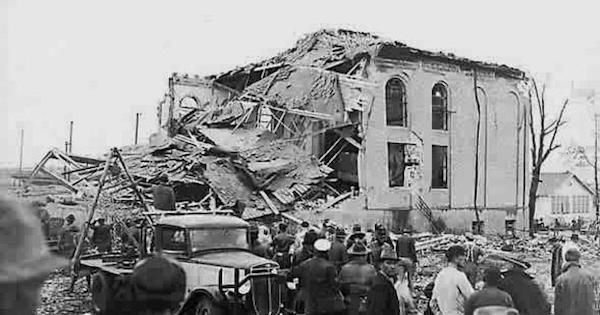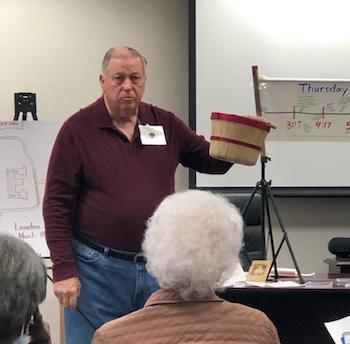
March 20, 2023 - At 3:17 PM on Thursday, March 18, 1937 a natural gas explosion in the London School in New London, Texas took the lives of 294 people, most of them children. This event was so tragic and horrific that tears welled in the eyes of some Timpson Area Genealogy and Heritage Society members as they listened to Jim Ross share a minute by minute account of the disaster at the Society's March meeting.
“In October of 1930 Dad Joiner's Daisy Bradford #3 well struck oil a few miles southeast of the community of New London in Rusk County and the great East Texas Oil Boom was on,” began retired educator and Honorary London Museum Ambassador Jim Ross. “Crude oil was selling for a dollar a barrel and a single well might produce 50,000 barrels a day. A lot of people were getting rich and that included school districts located in the oil fields. The London School District had more money per student than any other district in the country. No expense was spared in construction of the London School, which cost a million dollars and opened in 1933. Two key decisions were made in the construction of the school. First, it was decided that it would be heated by natural gas because it was so plentiful and cheap. Each room had its own gas heater, fed by a two inch natural gas pipeline beneath the school. Second, since fire was a concern, concrete, cinder block, tile, and steel were chosen as the building materials. Only the roof trusses were made of wood. The foundation was of pier and beam construction with a crawl space beneath eight inch thick concrete floors.”
“Viewed from the air, the school building was shaped like a capital E, with the upright portion of the E as the front, facing Texas Highway 42. Ironically, this is almost exactly the same configuration as the older portion of the current Timpson school building, which replaced the one destroyed by fire one week before the London School disaster. The elementary school was a separate building to the north. There was a frame gymnasium to the east of the building and a road circled behind the main school building,” Ross explained. “At 3 PM on March 18, most of the kindergarten through fourth grade students had boarded school busses lined up on the road behind the main building. The busses were waiting for the conclusion of a PTA meeting going on in the gym which included a program of students presenting The Mexican Hat Dance. School did not dismiss until 3:30 and many students and teachers remained in the main building, however.”
“Unbeknownst to anyone, the gas pipeline beneath the school had begun leaking and had filled the 64,000 cubic feet of crawl space beneath the first floor with explosive natural gas. The presence of the gas was undetectable because, in its natural state, gas is odorless,” Ross continued. “At 3:17 P,M the teacher in the wood shop turned on an electric sander, creating the spark which ignited the gas beneath the school. The concrete first floor was blown upwards by the explosion, causing the front portion of the building to collapse. The upright portion of the “E” facing the highway was completely destroyed, with the auditorium and two wings to the rear left standing. The building didn't explode as much as it imploded,” Ross explained. “The other buildings on the campus, including the gym where the PTA program was going on, and the school busses to the rear of the building were undamaged.”
“The first responders to the disaster were the mothers and teachers who were attending the PTA meeting. Running through the dust-filled air, they came upon the fifteen foot high pile of rubble that minutes before had been the London School. A heart-wrenching scene of mothers digging through the rubble with torn and bleeding hands, trying to free children who might be their own who were trapped in the wreckage ensued,” Ross shared. “Not long after the explosion, a man traveling north in a flat-bed truck loaded with peach baskets he had picked up from the factory in Jacksonville came upon the chaos at the school. Realizing what was happening, he began unloading the baskets for rescue workers to use in clearing the rubble.”
“As word of the disaster spread, workers from the oilfields and equipment began arriving to help, eventually swelling to about 3000. With telephone lines jammed and communication almost impossible, a man from a Henderson radio station arrived with equipment which he connected to the electric power lines, allowing calls for emergency workers and equipment to go out in a live broadcast, as well as lists of the location of injured survivors. The condition of many of the bodies made identification difficult,” Ross continued. “Believing that there had been a fire, fire trucks began arriving, only to be told that there was no fire. Roadways into New London were impassible because of the traffic. Emergency vehicles couldn't reach the school or evacuate the injured if they managed to get there. Initially, the radio station sent out calls for medical personnel, later having to change the appeal to mortuary services.”
“Because of their wealth, the school district had one of the first lighted football stadiums in the state. When darkness began to fall, workers climbed the light poles at the adjacent stadium and turned the lights to illuminate the explosion site. As rescue efforts continued into the night, rain began to fall. Workers were cold and wet but refused to stop. The thick coating of dust that covered the debris turned to mud. The Red Cross arrived and served over 50,000 sandwiches,” Ross revealed. “Gov. Allred declared martial law and sent in the National Guard. Upon arrival at the site, the Guard commander realized that he didn't have enough men to deal with the calamity, so he sent out a call for all of the Senior Boy Scouts in the area to come to New London in uniform. He issued them unloaded rifles and they worked with the Guard to restore order.”
“About midnight, two junior high students were found alive in the rubble. By 2 AM, about 150 bodies had been recovered and 300 injured had been sent for medical treatment. The new Mother Francis Hospital in Tyler which was to have opened the next day, opened early to serve the injured. Pickup trucks became ambulances. The American Legion Hall in Overton was used as a temporary morgue. Workers continued through the night, recovering bodies and occasionally an injured survivor,” Ross said.
“Walter Cronkite, a recent journalism graduate of The University of Texas, was in Dallas when he was ordered to go to New London to cover the story about 3 AM. He didn't know where New London was but was told to go to Tyler and ask directions. As he was making his way from Tyler to New London he was stopped by the National Guard and refused entry because he was a reporter, not a rescue worker. While he was there a portable light truck arrived, asking for directions to New London. Cronkite asked the driver for a ride and made it to the site. This was the first major story he ever covered,” Ross shared. He later said that the London School Explosion was the worst thing he ever saw in his career.
“By about 8 AM Friday morning all of the rubble had been cleared. Workers had removed about 4,000,000 pounds of debris. One report stated that it appears that the site had been swept with a broom. There were no more victims to be recovered. The funerals began on Saturday morning and continued for days. Local churches cancelled services on Sunday to allow funerals to be held, one after the other. Pleasant Hill Cemetery outside of New London became the burial site for about 100 victims. Some families had lost all of their children. Reading the inscriptions on the tombstones will tear your heart out,” confided Ross.
“News of the tragedy at New London spread throughout the world. Messages of condolence poured in, including a telegram from the First Lady, Eleanor Roosevelt and, incredibly, one from Adolph Hitler. A granite cenotaph bearing the names of all the victims was erected in front of the school in 1939. But over the years, the event was almost forgotten, largely because of the reluctance of those involved to talk about it. Everyone in New London had been touched by the tragedy and any found it too painful to recall. The grief was not limited to the community since people throughout East Texas had relatives or loved ones among the 294 victims. Teacher Laura Elizabeth Bell, age 32, is buried in Greenwood Cemetery in Garrison. Henry Bryan Bowlin, age 10, is buried in the Tennessee Cemetery outside of Timpson, as is Ruby Edna Peace, age 11. Glenn Turner Wood, age 11, is buried at Corinth Cemetery outside of Timpson,” revealed Ross. TAGHS member Dru Dickey brought a photo of her relative, Nellie Barnes, who died in the explosion.
“Amazingly, some good came out of this tragedy”, said Ross. “Texas passed the first law in the nation requiring the addition of an odor to natural gas to aid in the detection of leaks.”
The Timpson Area Genealogical Society meets at 2PM on the third Wednesday of each month in the meeting room of the Timpson Public Library on the corner of Austin and Bremond Streets in downtown Timpson. The TAGHS library is located within the Timpson Public Library and is open and staffed from 9AM until 5PM weekdays. Telephone 936-254-2966 and ask for the Genealogical Library.










